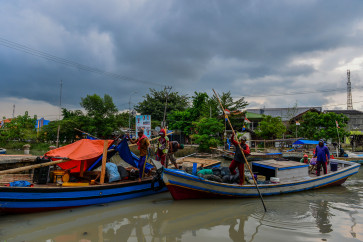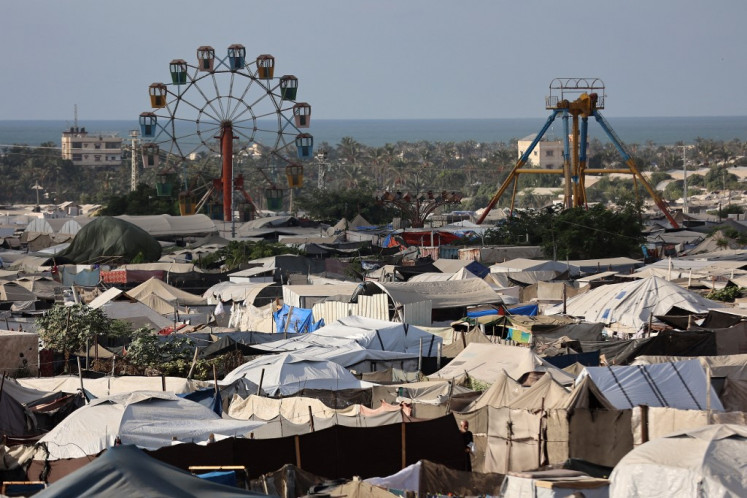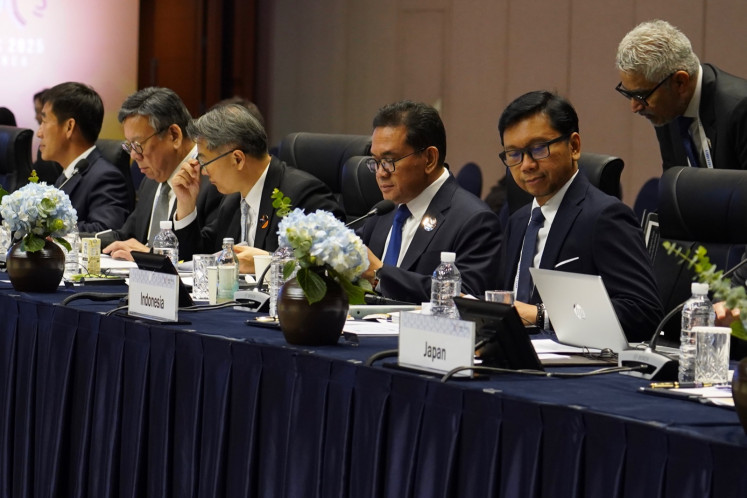Popular Reads
Top Results
Can't find what you're looking for?
View all search resultsPopular Reads
Top Results
Can't find what you're looking for?
View all search resultsWelcoming guests, Tengger style
Second thoughts: he dance presents the story of Roro Ateng (left) as he is chased by a spirit after his parents decline to sacrifice him to a volcano
Change text size
Gift Premium Articles
to Anyone
S
em>Second thoughts: he dance presents the story of Roro Ateng (left) as he is chased by a spirit after his parents decline to sacrifice him to a volcano.
Mount Bromo in East Java is inseparable from the Tengger people who live in Malang, Pasuruan, Probolinggo and Lumajang ' and in over a dozen villages in the Bromo Tengger Semeru National Park.
The Tengger, who have lived in the area for centuries, are thought to have descended from Majapahit royalty. Many adhere to a distinct form of Hinduism, although there are also Muslim and Christians.
Most make their living as farmers. Unsurprisingly, their rituals are focused on nature. The Tengger lead modest lives, receiving outsiders warmly while preserving their group's identity.
This was evident when some Tengger recently welcomed members of the Blazer Indonesia Club automotive community to the vast sand plain around Mount Bromo.
People from Tosari, Ngadiwono and Wonokitri organized a ceremony for the guests, who drove to the mountain to create a record to be verified by the Indonesian Museum of Records (MURI).
'We present our baleganjur gamelan to greet our visitors,' said orchestra leader Karyadi during the ceremony.
The Tengger are happy to welcome guests formally, provided their intentions are good and that they agree to adhere to local customs. 'They can [be welcomed] in a village or even in the sand, like now,' Karyadi said.
The sand sea ' called the lautan pasir in Indonesian ' that surrounds Bromo spans almost 10 kilometers square. It sits at an altitude of 2,329 meters and was formed from volcanic ash.
Karyadi said the welcome ritual was meant to beseech the consent of the supreme power of the universe to the attainment of the visitors' goals.
Before welcome dances were performed, club members drove through a penjor, or gate adorned with bamboo poles and coconut leaves.
According to Karyadi, the decorations represent panca wara ' the five-day week in local Hindu culture ' and the yellow leaves signify peace.
The dances presented by young artists depicted the story of Roro Anteng and Jaka Seger.
Orchestra: Members of the community's baleganjur gamelan accompany the dancers.
One of the Tengger's most famous ancestors is Raden Hadi Kusuma, the 25th child of Joko Seger, the son of a brahman, and Rara Anteng, the daughter of Majapahit king, who lived in Mt. Bromo's crater.
In the beginning, so the legend goes, the couple asked Sang Hyang Widhi (God) to give them children.
Their prayer was granted ' on the condition that they sacrificed their youngest child to Bromo, which they accepted.
The couple was said to have 25 children, with Raden Hadi Kusuma as the youngest.
However, Joko Seger and Rara Anteng overlooked their pledge to the boy ' prompting God to send a giant to demand His due. A begawan (sage) is then sent by the couple to fight the giant and protect their son.
The gamelan accompanying the dance was steeped in Balinese music, as the Tengger are closely connected to the Balinese in faith, rituals, traditions and arts.
'The Balinese also regard their forebearers as coming from the Majapahit,' said a representative of the Indonesia Hinduism Society in Tosari.
After the opening performance, a local shaman led the welcome rite as the guests sat cross-legged behind him.
They were praying before a tumpeng rice cone garnished with bounty from the farmers' fields. 'The cone symbolizes gratitude to the supreme power of Tengger and the universe that has supplied all our needs,' the official noted.
The shaman then fitted udeng (headdresses) on several representatives of the guests, proclaiming them sahabat Tengger (friends of Tengger), followed by the distribution of the rice to those present.
Karyadi said that the ceremony was intended to make people aware of Tengger's culture.
This tradition is also preserved to educate the young, which is difficult given the poverty and isolation of the community, Karyadi, who also gives religious lessons at his art studio in Tosari, said.
A junior high school graduate, Karyadi said he was a self-taught man who continued to follow technological developments. 'Thank God, the studio has now been equipped with computers and Internet connections so that my students are technologically literate and have broader horizons.'
'With their broader knowledge and perspective, members of the younger generation can at least play a greater role in preserving local traditions as well as promoting the Tengger community's agricultural development,' Karyadi said.
' Photos by Nedi Putra AW












